Remotes in GitLab
Last updated on 2025-09-29 | Edit this page
Estimated time: 65 minutes
Overview
Questions
- How do I safely back up my work to a remote site?
- How do I share my changes with others on the web?
Objectives
- Explain what remote repositories are and why they are useful.
- Push to or pull from a remote repository.
Version control really comes into its own when we begin to collaborate with other people. We already have most of the machinery we need to do this; the only thing missing is to copy changes from one repository to another.
Systems like Git allow us to move work between any two repositories. In practice, though, it is easiest to use one copy as a central hub, and to keep it on the web rather than on someone’s laptop. Most programmers use hosting services like GitHub, Bitbucket or GitLab to hold those main copies.
Let us start by sharing the changes we have made to our current project with the world. To this end we are going to create a remote repository that will be linked to our local repository.
This next section has the potential to go very wrong for learners if they do not follow along with the instructor and do everything the instructor does. Instructors should go 3x slower than you think you should. Emphasize the following points:
- Learners should NOT skip ahead
- Follow what the instructor does exactly
- Select your personal username in the group dropdown. Many people will have this field automatically populated with other groups that they are members of.
- UNCHECK the “Initialize repository with a README”
1. Create a remote repository
Log in to USGS GitLab, then
click on the icon in the top right corner to create a new project called
vampires-and-werewolves:

Select Create blank project
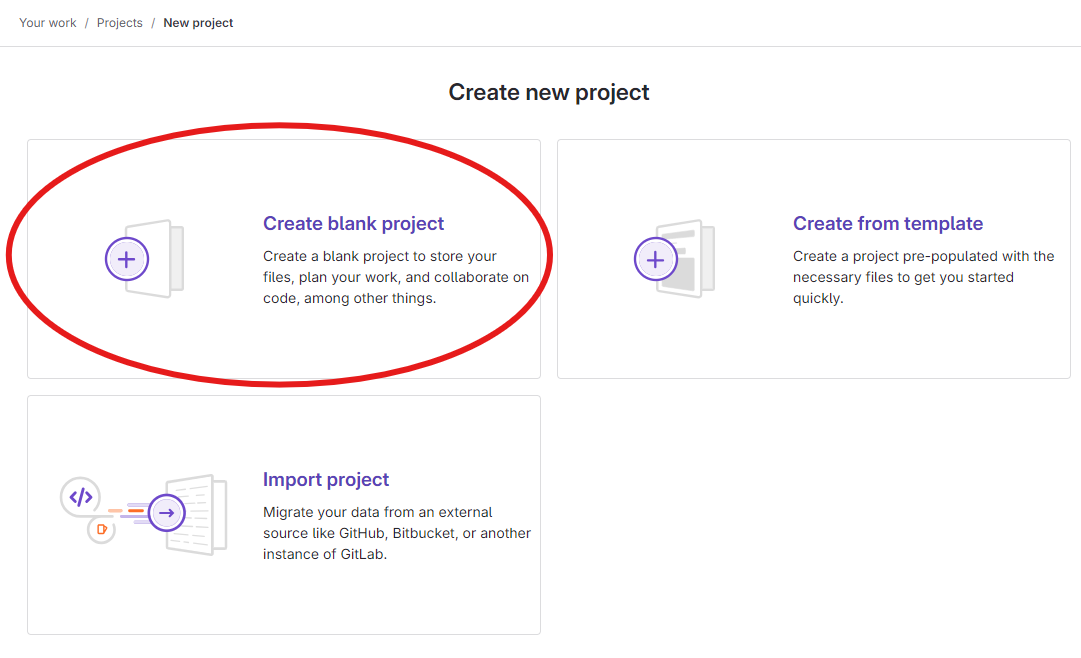
Name your project “vampires-and-werewolves”, select your username as
the namespace, uncheck “Initialize repository with a
README”, and then click Create project.
Note: Since this repository will be connected to a local repository, it needs to be empty. That is why “Initialize repository with a README” needs to be unchecked. See the “GitLab README files” exercise below for a full explanation of why the project needs to be empty.
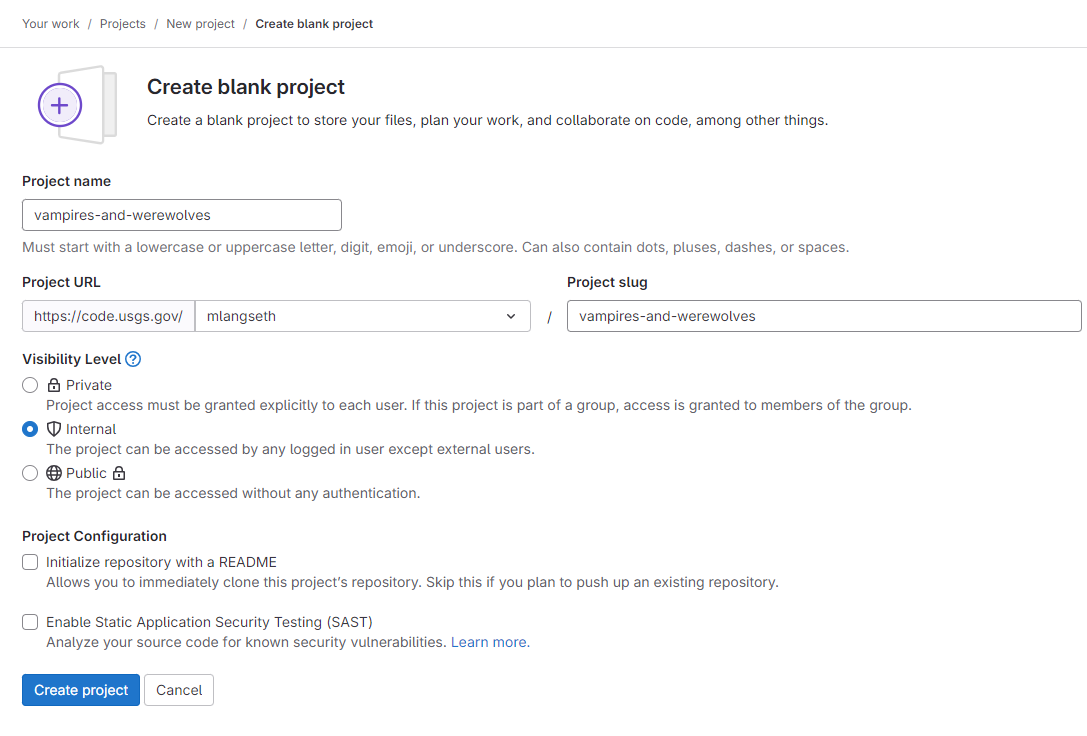
As soon as the repository is created, GitLab displays a page with a URL and some information on how to configure your local repository:
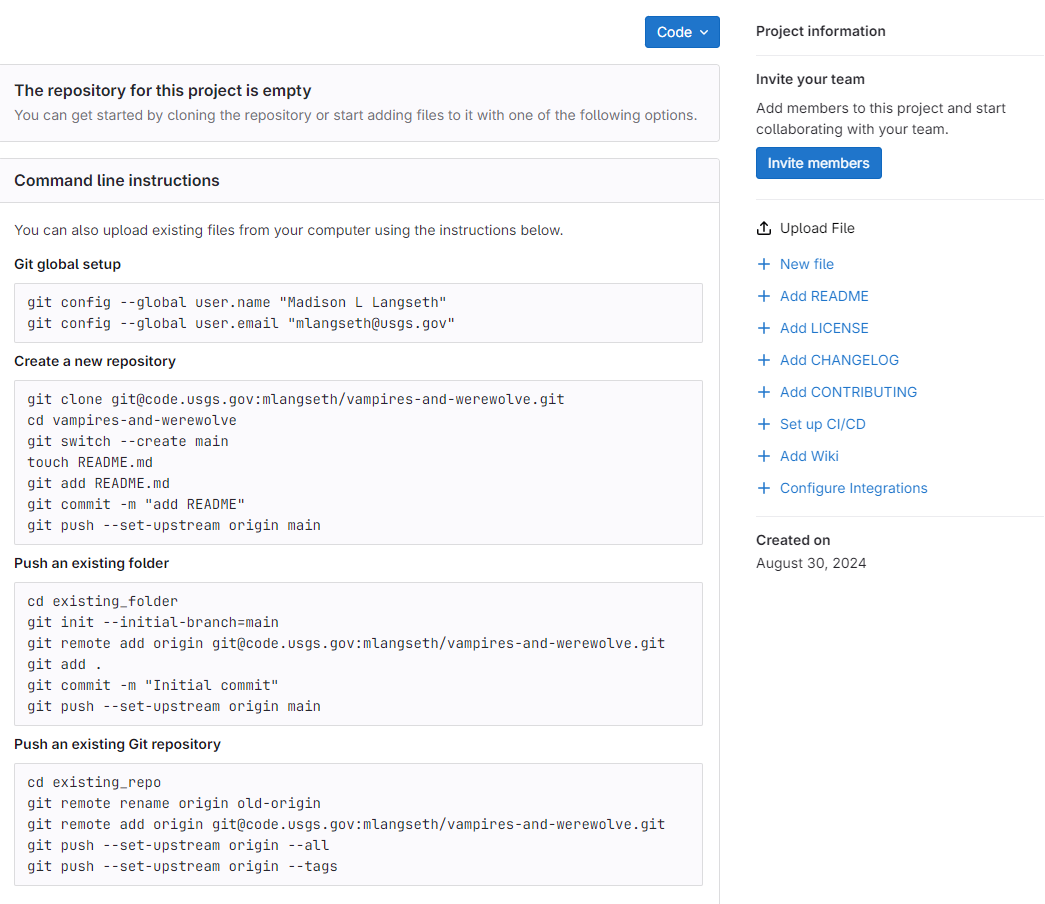
This effectively does the following on Gitlab’s servers:
If you remember back to the earlier episode where we added and committed our earlier
work on mars.txt, we had a diagram of the local repository
which looked like this:
Now that we have two repositories, we need a diagram like this:
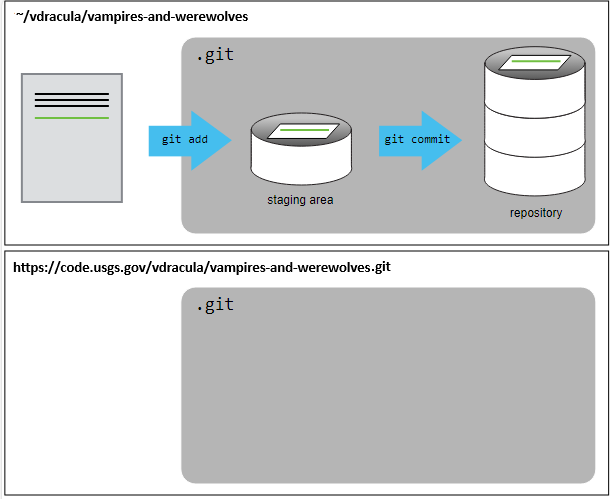
Note that our local repository still contains our earlier work on
mars.txt, but the remote repository on GitLab appears empty
as it does not contain any files yet.
2. HTTPS Setup
Before Dracula can connect to a remote repository, he needs to set up a way for his computer to authenticate with GitLab so it knows it is him trying to connect to his remote repository.
We are going to set up an “Access token” that we can use to authenticate to GitLab.
In GitLab, click on your user icon and then
Preferences.
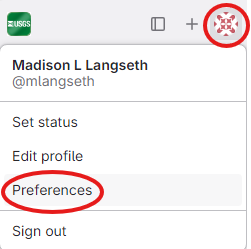
Once you are in your User Settings, click on
Access tokens. If you already have a personal access token
and you have it saved, you do not need to follow these steps. If you do
not have a personal access token, click on
Add new token.
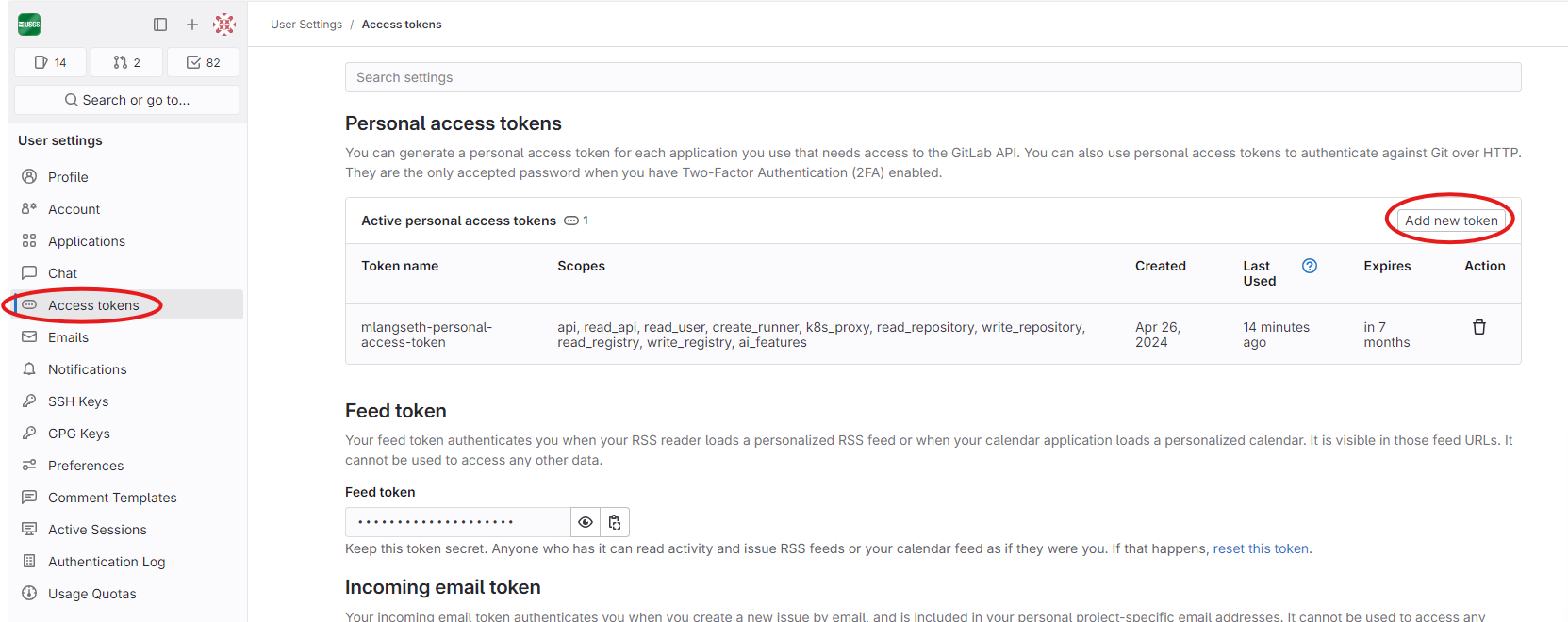
Add a token name that will be meaningful to you. If you are setting
this up as your primary access token for GitLab, you will probably want
to select all of the scopes. These scopes establish what you are able to
do in GitLab with this personal access token. You may also want to
delete the expiration date. If removed, GitLab will automatically set
the expiration date to the maximum of one year from the day created.
Then, click Create personal access token.
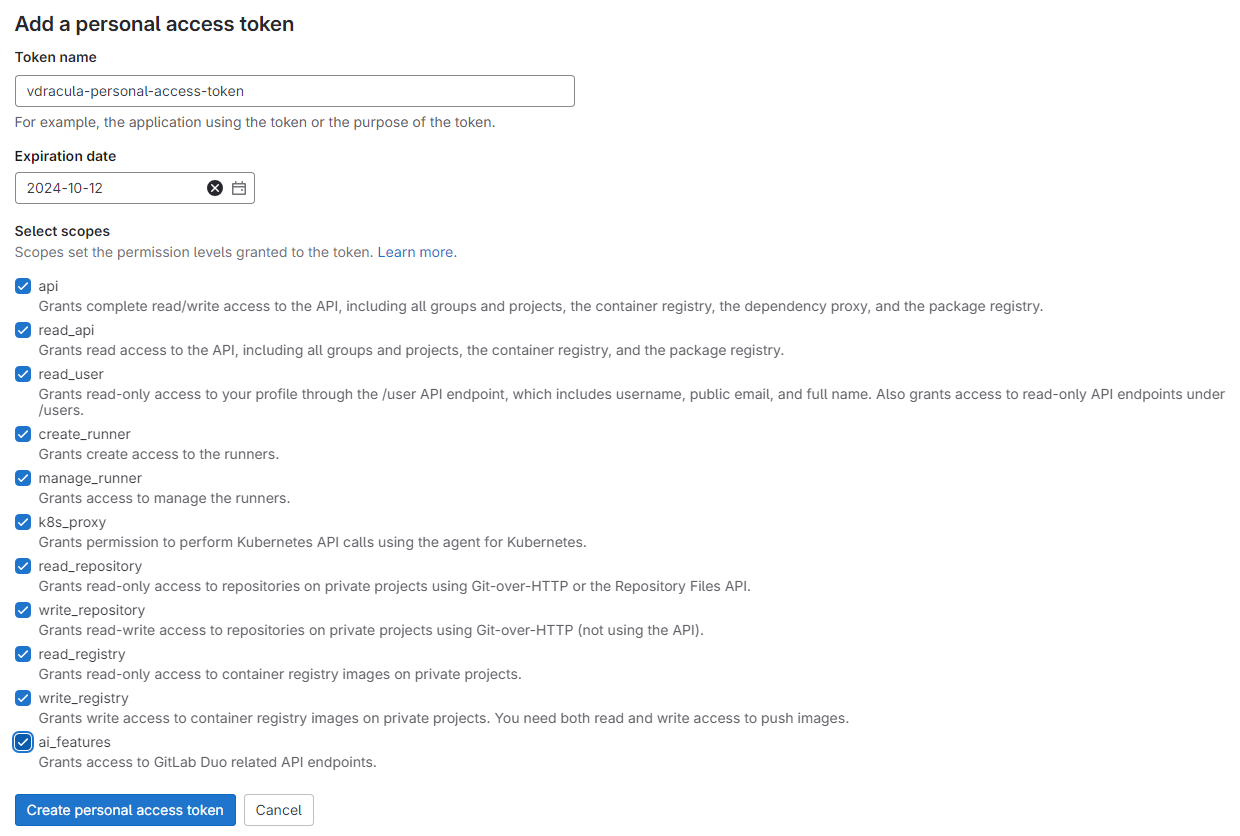
You will be presented with your new personal access token. Make sure you save it some place secure since you will not be able to access it again through GitLab.

See the GitLab Documentation for more information on personal access tokens.
When you start interacting with the remote from your computer, if you have not already saved your personal access token, you will be prompted to enter a username and password. The prompt may appear in your command prompt or you may get a pop up on your machine. Your username will be your email address and the password will be your personal access token. See the Password Manager spoiler below for more information on saving your personal access token and handling token expiration.
3. Connect local to remote repository
Now we connect the two repositories. We do this by making the GitLab repository a remote for the local repository. The home page of the repository on GitLab includes the URL string we need to identify it:

Click on the clipboard icon under ‘Clone with HTTPS’ to use the HTTPS protocol.
HTTPS allows you to communicate with GitLab using the HTTPS protocol. This approach tends to be a little simpler and allows you to use a Personal Access Token (similar to a password) to authenticate. You can use the same Personal Access Token across multiple machines.
SSH is considered slightly more secure and requires setting up a public and a private key. There is a little more overhead to using SSH over HTTPS, especially if working on more than one machine, which is why we teach the HTTPS method in this Lesson. That being said, it is not too hard to configure your account to use SSH and the instructions are available at https://docs.gitlab.com/ee/user/ssh.html.
With the URL copied from the browser, go into the local
vampires-and-werewolves repository, and run this
command:
Make sure to use the URL for your repository rather than Vlad’s: the
only difference should be your username instead of
vdracula.
origin is a local name used to refer to the remote
repository. It could be called anything, but origin is a
convention that is often used by default in git and GitLab, so it is
helpful to stick with this unless there is a reason not to.
We can check that the command has worked by running
git remote -v:
OUTPUT
origin git@code.usgs.gov:vdracula/vampires-and-werewolves.git (fetch)
origin git@code.usgs.gov:vdracula/vampires-and-werewolves.git (push)We will discuss remotes in more detail in a future episode, while talking about how they might be used for collaboration.
4. Push local changes to a remote
Now that authentication is setup, we can return to the remote. This command will push the changes from our local repository to the repository on GitLab:
Since Dracula set up a personal access token, it will prompt him for it. If you have already saved your personal access token in Git, it may not prompt for a password.
Emphasize that the pop up prompt that comes up my not be obvious or it may be hidden. If they don’t receive a pop up the first time, they should try again.
OUTPUT
Enumerating objects: 16, done.
Counting objects: 100% (16/16), done.
Delta compression using up to 8 threads.
Compressing objects: 100% (11/11), done.
Writing objects: 100% (16/16), 1.45 KiB | 372.00 KiB/s, done.
Total 16 (delta 2), reused 0 (delta 0)
remote: Resolving deltas: 100% (2/2), done.
To https://code.usgs.gov/vdracula/vampires-and-werewolves.git
* [new branch] main -> mainTroubleshooting Tips
-
Error: fatal: pathspec 'origin' did not match any files- Ensure that the URL for the repository is set properly
(
git remote -v) - If it is not correct, update it with
git remote set-url origin NEW_URL
- Ensure that the URL for the repository is set properly
(
- If a learner forgot to uncheck “Initialize with README”, there are
two potential solutions:
- Force the work from your local repo:
git push --force origin main - If the repo does not allow a forced push to protected branches, pull
from the remote repo first:
git pull origin main --allow-unrelated-histories
- Force the work from your local repo:
- If a learner already has a GitLab credential, they may need to delete it from their Credentials Manager. Then, try running the command again and Git Bash should prompt for new credentials.
Proxy
If the network you are connected to uses a proxy, there is a chance that your last command failed with “Could not resolve hostname” as the error message. To solve this issue, you need to tell Git about the proxy:
BASH
$ git config --global http.proxy http://user:password@proxy.url
$ git config --global https.proxy https://user:password@proxy.urlWhen you connect to another network that does not use a proxy, you will need to tell Git to disable the proxy using:
If your operating system has a password manager configured,
git push will try to use it when it needs your username and
password. For example, this is the default behavior for Git Bash on
Windows. If you want to type your username and password at the terminal
instead of using a password manager, type:
in the terminal, before you run git push. Despite the
name, Git
uses SSH_ASKPASS for all credential entry, so you may
want to unset SSH_ASKPASS whether you are using Git via SSH
or https.
You may also want to add unset SSH_ASKPASS at the end of
your ~/.bashrc to make Git default to using the terminal
for usernames and passwords.
If your personal access token was saved in your password manager and
it expires, you will need to generate a new personal access token and
open the password manager to delete the saved credential. Then, Git will
prompt you for the new password on your next git push.
Our local and remote repositories are now in this state:
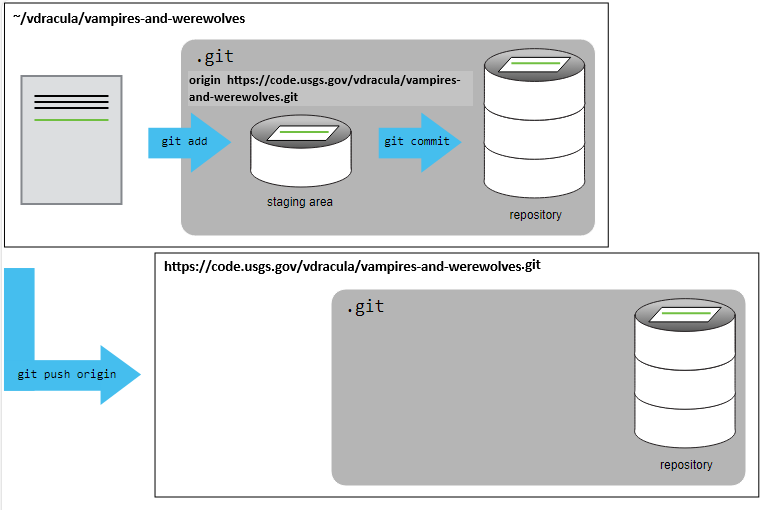
The ‘-u’ Flag
You may see a -u option used with git push
in some documentation. This option is synonymous with the
--set-upstream-to option for the git branch
command, and is used to associate the current branch with a remote
branch so that the git pull command can be used without any
arguments. To do this, simply use git push -u origin main
once the remote has been set up.
We can pull changes from the remote repository to the local one as well:
OUTPUT
From https://code.usgs.gov/vdracula/vampires-and-werewolves
* branch main -> FETCH_HEAD
Already up-to-date.Pulling has no effect in this case because the two repositories are already synchronized. If someone else had pushed some changes to the repository on GitLab, though, this command would download them to our local repository.
GitLab GUI
Browse to your vampires-and-werewolves repository on
Gitlab. On the right side menu under Project Information, find and click
on the text that says “XX commits” (where “XX” is some number). Hover
over, and click on, the two buttons to the right of each commit.
Additionally, click into each commit. What information can you
gather/explore from these buttons and views? How would you get that same
information in the shell?
The left-most button (with the picture of a clipboard) copies the
full identifier of the commit to the clipboard. In the shell,
git log will show you the full commit identifier for each
commit.
The right-most button lets you view all of the files in the
repository at the time of that commit. To do this in the shell, we would
need to checkout the repository at that particular time. We can do this
with git checkout ID where ID is the identifier of the
commit we want to look at. If we do this, we need to remember to put the
repository back to the right state afterwards!
When you click on the commit name, you will see all of the changes
that were made in that particular commit. Green shaded lines indicate
additions and red ones removals. In the shell we can do the same thing
with git diff. In particular,
git diff ID1..ID2 where ID1 and ID2 are commit identifiers
(e.g. git diff a3bf1e5..041e637) will show the differences
between those two commits.
Uploading files directly in GitLab browser
GitLab also allows you to skip the command line and upload files
directly to your repository without having to leave the browser. When
you are in Code –> Repository, you can
click the + button in the toolbar at the top of the file
tree, then click Upload File under
This directory.
GitLab Timestamp
Go to the repo you just created on GitLab and check the timestamps of the files. How does GitLab record times, and why?
GitLab displays timestamps in a human readable relative format (i.e. “22 hours ago” or “three weeks ago”). However, if you hover over the timestamp, you can see the exact time at which the last change to the file occurred.
Push vs. Commit
In this episode, we introduced the “git push” command. How is “git push” different from “git commit”?
When we push changes, we are interacting with a remote repository to update it with the changes we have made locally (often this corresponds to sharing the changes we have made with others). Commit only updates your local repository.
GitLab README files
In this episode we learned about creating a remote repository on GitLab, but when you initialized your GitLab repo, you did not add a README.md file. If you had, what do you think would have happened when you tried to link your local and remote repositories?
In this case, we would see a merge conflict due to unrelated histories. When GitLab creates a README.md file, it performs a commit in the remote repository. When you try to pull the remote repository to your local repository, Git detects that they have histories that do not share a common origin and refuses to merge.
OUTPUT
warning: no common commits
remote: Enumerating objects: 3, done.
remote: Counting objects: 100% (3/3), done.
remote: Total 3 (delta 0), reused 0 (delta 0), pack-reused 0
Unpacking objects: 100% (3/3), done.
From https://code.usgs.gov/vdracula/vampires-and-werewolves
* branch main -> FETCH_HEAD
* [new branch] main -> origin/main
fatal: refusing to merge unrelated historiesYou can force git to merge the two repositories with the option
--allow-unrelated-histories. Be careful when you use this
option and carefully examine the contents of local and remote
repositories before merging.
OUTPUT
From https://code.usgs.gov/vdracula/vampires-and-werewolves
* branch main -> FETCH_HEAD
Merge made by the 'recursive' strategy.
README.md | 1 +
1 file changed, 1 insertion(+)
create mode 100644 README.md- A local Git repository can be connected to one or more remote repositories.
- Use the HTTPS protocol to connect to remote repositories.
-
git pushcopies changes from a local repository to a remote repository. -
git pullcopies changes from a remote repository to a local repository.


